
Je cadeautjes zeker op tijd in huis hebben voor de feestdagen? Kom langs in onze winkels en vind het perfecte geschenk!
- Afhalen na 1 uur in een winkel met voorraad
- Gratis thuislevering in België vanaf € 30
- Ruim aanbod met 7 miljoen producten
Je cadeautjes zeker op tijd in huis hebben voor de feestdagen? Kom langs in onze winkels en vind het perfecte geschenk!
- Afhalen na 1 uur in een winkel met voorraad
- Gratis thuislevering in België vanaf € 30
- Ruim aanbod met 7 miljoen producten
Zoeken
Omschrijving
Mexican-American life, like that of nearly every contemporary community, has been extensively photographed. Yet there is surprisingly little scholarship on Chicano photography. Picturing the Barrio presents the first book-length examination on the topic. David William Foster analyzes the imagery of ten distinctive artists who offer a range of approaches to portraying Chicano life. The production of each artist is examined as an ideological interpretation of how Chicano experience is constructed and interpreted through the medium of photography, in sites ranging from the traditional barrio to large metropolitan societies. These photographers present artistic as well as documentary images of the socially invisible. They and their subjects grapple with definitions of identity, as well as ethnicity and gender. As such, this study deepens our understanding of the many interpretations of the "Chicano experience."
Specificaties
Betrokkenen
- Auteur(s):
- Uitgeverij:
Inhoud
- Aantal bladzijden:
- 240
- Taal:
- Engels
- Reeks:
- Reeksnummer:
- nr. 10
Eigenschappen
- Productcode (EAN):
- 9780822964391
- Verschijningsdatum:
- 16/05/2017
- Uitvoering:
- Paperback
- Formaat:
- Trade paperback (VS)
- Afmetingen:
- 178 mm x 226 mm
- Gewicht:
- 408 g

Alleen bij Standaard Boekhandel
+ 167 punten op je klantenkaart van Standaard Boekhandel
Beoordelingen
We publiceren alleen reviews die voldoen aan de voorwaarden voor reviews. Bekijk onze voorwaarden voor reviews.









